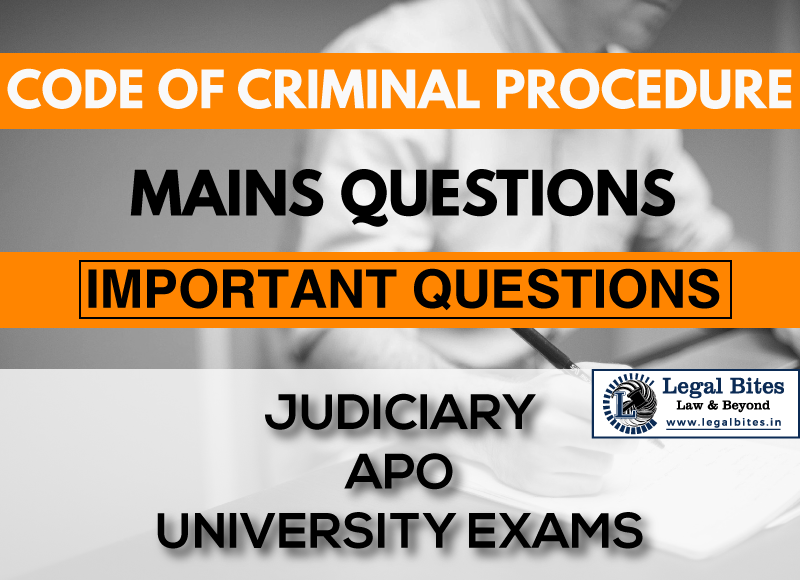What is the distinction between the provisions of Sections 340 and 344 of CrPC relating to the offence affecting the administration of justice?
Question: What is the distinction between the provisions of Sections 340 and 344 of CrPC relating to the offence affecting the administration of justice? Find the answer only on Legal Bites. [What is the distinction between the provisions of Sections 340 and 344 of CrPC relating to the offence affecting the administration of justice?] Answer Chapter XIV of… Read More »

Question: What is the distinction between the provisions of Sections 340 and 344 of CrPC relating to the offence affecting the administration of justice?
Find the answer only on Legal Bites. [What is the distinction between the provisions of Sections 340 and 344 of CrPC relating to the offence affecting the administration of justice?]
Answer
Chapter XIV of the CrPC sets out conditions requisite for initiation of proceedings and Chapter XXVI of the said Code makes provision as to offences affecting the administration of justice.
Section 340 of CrPC provides for the procedure in cases mentioned in section 195 of the said Code and section 344 provides for the summary procedure for trial for giving false evidence. The provisions of section 195 and section 344 of the Code are independent of each other and they operate in different circumstances.
If for example an offence punishable under section 193 of the IPC is alleged to have been committed in civil proceedings, the procedure that is required to be followed for the trial of such an offence will be governed by the provisions of section 195 of the CrPC read with section 340 of the said Code.
However, if an offence punishable under section 193 of the IPC is alleged to have been committed in a judicial proceeding before the Court of Sessions or a Magistrate First Class, the provisions of section 344 of the CrPC will come into play and notwithstanding the provisions of section 195 of the said Code, the Court concerned i.e. either Court of Sessions or Magistrate, First Class has the power to initiate summary proceedings as contemplated under section 344 of the CrPC. Such power of summary trial is not available to a Civil Court.
The intention of the legislature must be read as is reflected from the provisions of the statute concerned and if so read it will have to be held that the Court of Sessions or Magistrate of the First Class has two options before him if an offence punishable under section 193 of the IPC is committed before such a Court or in the presence of such a Court namely either he can forward the complaint to the Magistrate so that the concerned Magistrate will take cognizance under section 195 of the CrPC and follow the further procedure as is set out under section 340 or follow the second alternative namely to start summary proceedings as contemplated under section 344 of the CrPC.
This view is duly supported by a judgment of the Division Bench of this Court in the case of Balshiram Rambhau Awate v. State of Maharashtra, 1978 CriLJ 821.
The provisions of Section 340 and Section 344 of the CrPC apparently appear to be similar but they are distinct provisions and differ from each other in certain key aspects. The distinction between the two provisions is as follows:
- While section 340 is a general section containing provisions relating to the procedure to be followed in respect of certain offences affecting the administration of justice, section 344 contains a special provision that deals with the procedure to be followed in cases where a person appearing as a witness gives false evidence or fabricates false evidence.
- Section 344 is restricted to a judicial proceeding in its application but there is no such restriction in the application of Section 340.
- Section 340 requires the court to conduct first a preliminary inquiry before making a complaint. On the other hand, section 344 allows the court to file a complaint even without making a preliminary inquiry.
- Section 344 necessitates the Court to give a finding in the judgment or final order itself that the person appearing as a witness has intentionally and deliberately given false evidence or fabricated false evidence. The Court is also required to state that prosecution is expedient in the interest of justice for the eradication of the evil of perjury. However, no such finding is necessary under Section 340.
- Under Section 340, the court may take suo moto action or on an application by a person but in Section 344 there is no contemplation of application from any person
- Under Section 340, the Court cannot itself assume jurisdiction to try the accused person, but it may make a complaint. On the other hand, Section 344 empowers the Court to itself try the perjurer summarily.
- The provisions contained in Section 344 of the code are more stringent than those of Section 340 insofar as there is no right of appeal against an order under Section 344. As against this, the right of appeal against an order made under Section 340 is provided in Section 341 of the Code.
- CRPC Mains Questions Series Part I: Important Questions
- CRPC Mains Questions Series Part II: Important Questions
- CRPC Mains Questions Series Part III: Important Questions
- CRPC Mains Questions Series Part IV: Important Questions
- CRPC Mains Questions Series Part V: Important Questions
- CRPC Mains Questions Series Part VI: Important Questions
- CRPC Mains Questions Series Part VII: Important Questions
- CRPC Mains Questions Series Part VIII: Important Questions
- CRPC Mains Questions Series Part IX: Important Questions
- CRPC Mains Questions Series Part X: Important Questions
- CRPC Mains Questions Series Part XI: Important Questions

